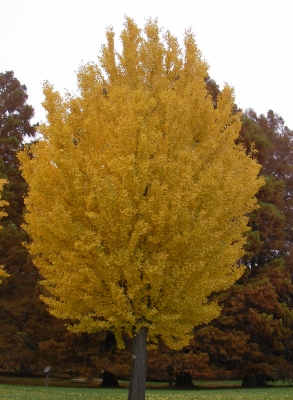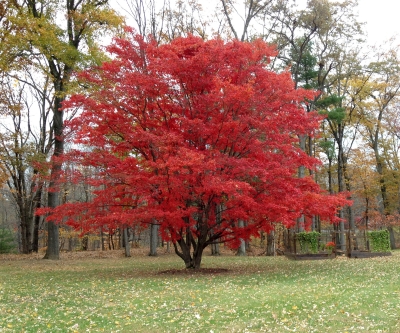Autumn’s Leaves
Wherefrom the Colors?
Autumn is a season when New York’s Hudson Valley, and much of the Northeast, unfolds in all its glory. Not this autumn, though. What’s going on in the leaves this year? Is there anything I can do about it?.
Chlorophyll is what makes leaves green, but hidden behind that green, all season long, are some of autumn’s colors. Chlorophyll must be continually synthesized for a leaf to stay green. The shorter days and lowering sun of waning summer are what trigger leaves to stop producing chlorophyll and let some of the other colors come to the fore.
Yellows and oranges, no longer masked by chlorophyll green, come from carotenoids, which help chlorophyll do its job of harvesting sunlight to convert into plant energy. Thank carotenoids for the warm, yellow glow they give to gingko, aspen, hickory, and birch leaves.

Gingko
Tannins are another pigment, actually metabolic wastes, that all summer are hidden by chlorophyll. Their contribution to the fall palette are the season’s subdued browns, notable in some oaks and enriching the yellow of beeches.
Because leaves harbor carotenoids and tannins all summer long, nothing particular about autumn weather should either intensify or subdue their autumn showing. I’m blaming this autumn’s poor show on the season’s extended warm weather. It was slow to arrest chlorophyll production and induce leaf drop. A couple of hard freezes brought the whole works to a screeching halt, so instead of showy yellow leaves, my witchhazel’s stems are now “adorned” with wrinkled, green leaves frozen in place. Other trees and shrubs suffered a similar fate, and their frozen, green leaves are dropping without any fanfare.
Autumn color also spills out reds and purples, most evident in red maples and some sugar maples, scarlet oak, sourwood, blueberry, and winged euonymus. Those reds and purples come from anthocyanins, yet another pigment. Except for trees like Purple Fountain beech and Royal Purple smokebush, whose leaves unfold dusky red right from the get go in spring and remain so all season long, in most leaves anthocyanins do not begin to develop until autumn.

Sugar maple
Anthocyanin formation requires sugars, which accumulate best with a combination of warm, sunny days to maximize photosynthesis, and cool, but not frigid, nights to minimize nighttime burning up of accumulated sugars. A cloudy, rainy autumn means less red because less anthocyanin is formed, and any that does form is diluted. Warm nights, such as characterized much of autumn, reduce anthocyanins by burning up much of each day’s sugar production. The result: Less reds and purples, as evidenced by the blah color of this year’s blueberries in my garden and maples in the forests.
Can We Make the Color Better?
Is there anything we can do about the autumn show?
Here in the garden, my role in the autumn show is to plant trees genetically programmed for good autumn color. Colorful trees and shrubs include goldenrain tree, hickory, ironwood, and black tupelo. Certain varieties within each species might pack a bigger wow than the others. Hence the spicebush variety Rubra, brick red in fall, or Wright Brothers sugar maple, whose leaves become a mottling of gold, pink, orange, and scarlet. Other especially colorful varieties include Autumn Flame and October Glory red maple, Commemoration and Legacy sugar maple, Autumn Gold and President gingko, and September Beauty Chinese sumac.

Japanese maple
Despite this autumn’s weather, fothergilla and Japanese stewartia both managed to look as flamboyant this year as in others. If you believe that, going forward, autumn weather is going to bring on less spectacular color, choose varieties that originated from more southerly latitudes.

Fothergilla

Stewartia
And if warmer autumns are going to be one effect of global warming, we can help the autumn show beyond our gardens, in the forests, by traveling less or more efficiently, using less plastic and other petrochemicals, eating more locally grown food and less farmed meat, investing in energy-efficient appliances and renewable energy, etc. (For more, see https://www.conserve-energy-future.com/stopglobalwarming.php.)
Back in the garden, my other role in ratcheting up the reds and purples is to make sure that leaves bask in light. I plant a tree where light is adequate (for that species) and, as necessary, prune so that branches don’t shade each other. Street lights don’t count as light, and actually have a negative effect, disrupting the signal that days are getting shorter and it’s time to slow chlorophyll production.
Lee’s New Book!!
Knowing something about how plants work can make gardening more interesting as well as make the landscape prettier and vegetable gardens more productive. And that’s the thrust of my upcoming book, The Ever Curious Gardener: Using a Little Natural Science for a Much Better Garden, to be published in early spring of 2018 but available for pre-order through Amazon or, signed, from me.



Congratulations on your new book! And I was wondering about the blah leaf color, a bit more detailed explanation than I’ve found elsewhere.
Looking forward to the new book!